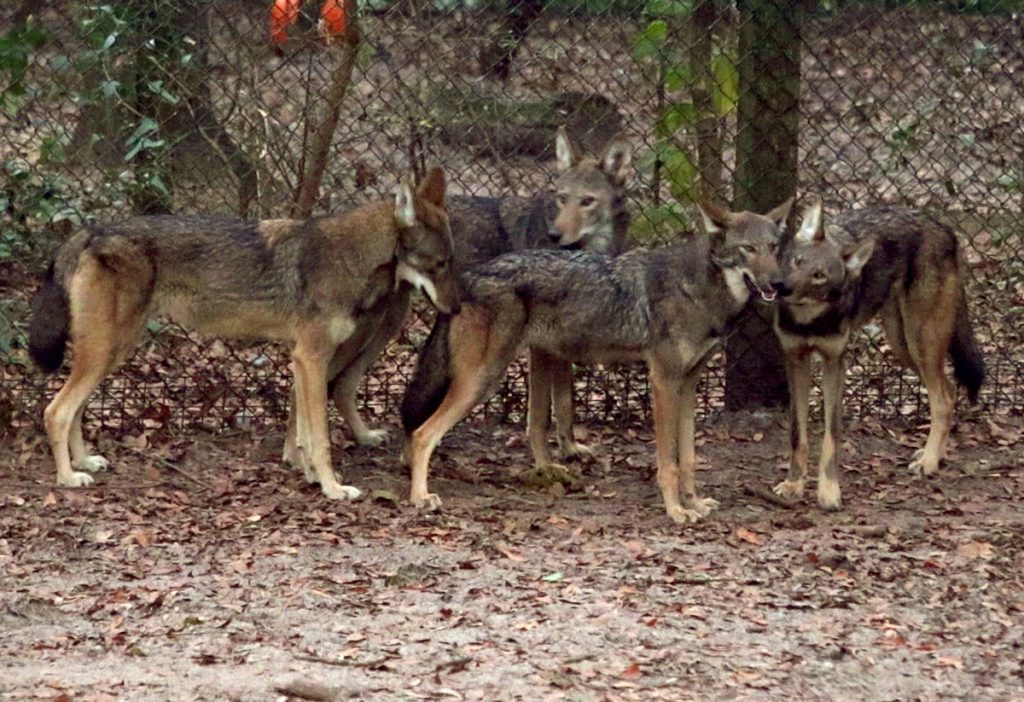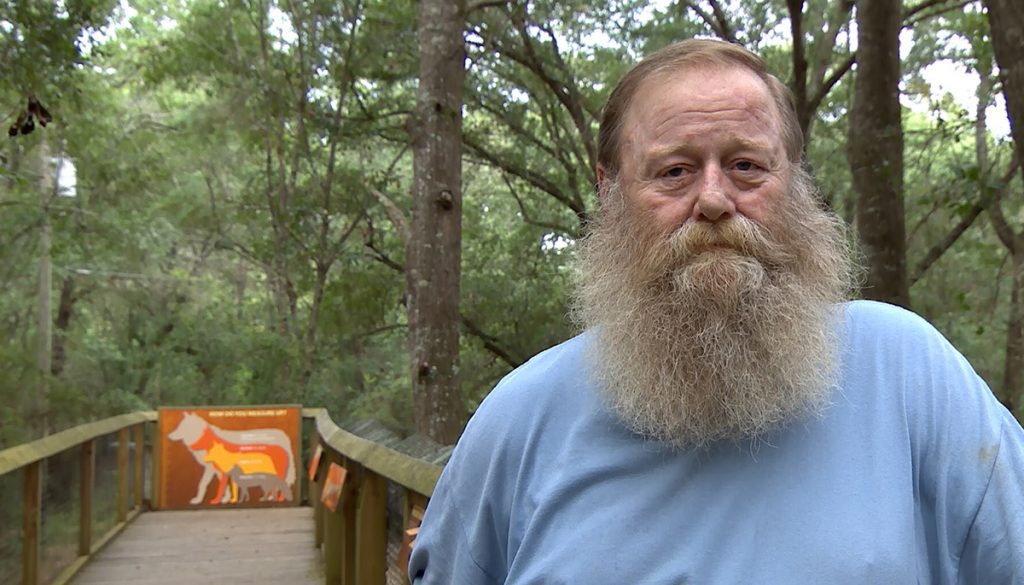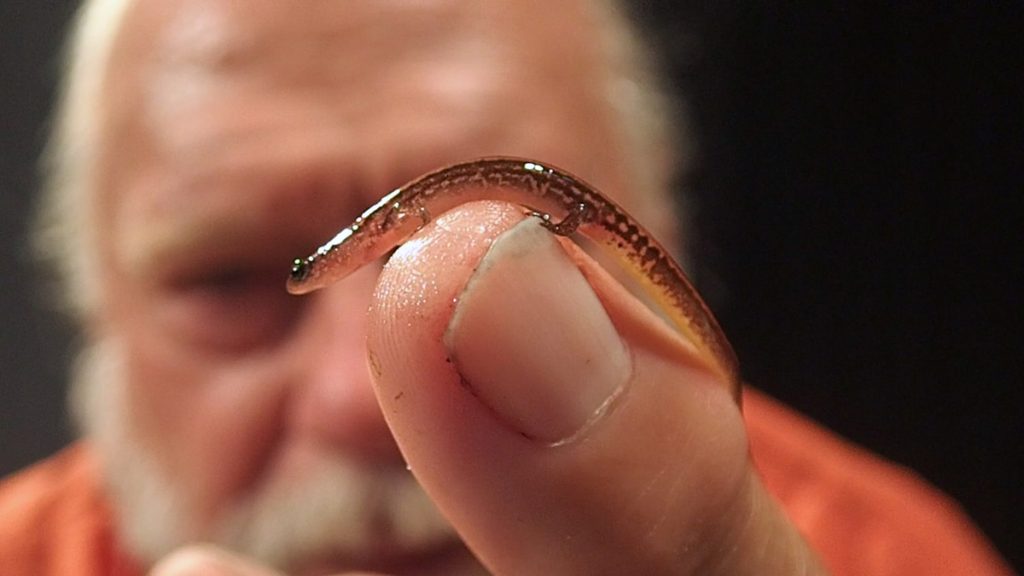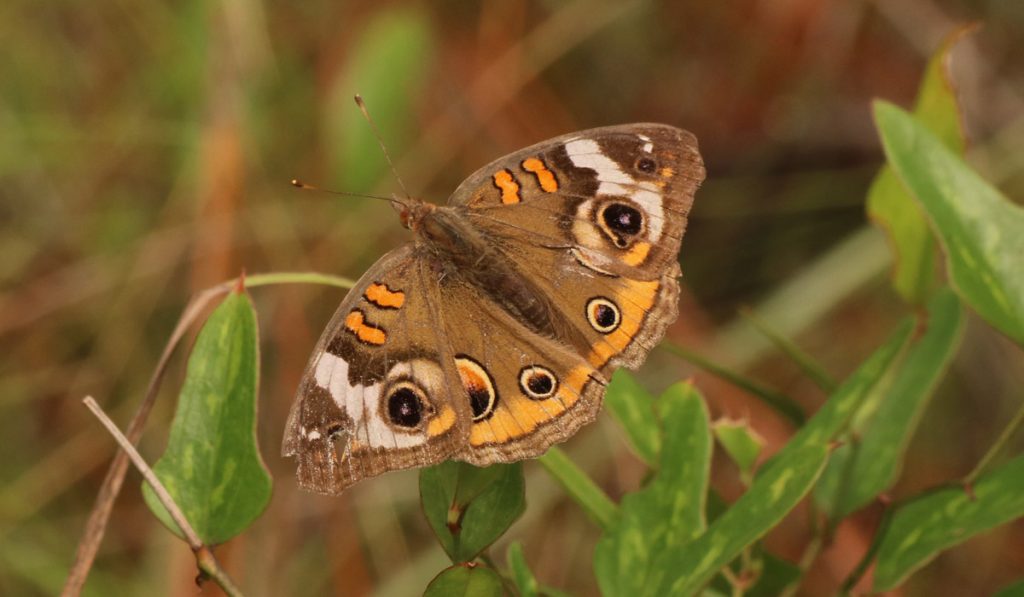Not only are the Tallahassee Museum’s red wolf pups getting big- they’re going to be here longer than originally expected. Learn more below:
Rob Diaz de Villegas WFSU Public Media
When I get to the enclosure, three red wolves of similar size are out. At first it looks like three adults, one more than I know should be here. The father wolf has always been easy to pick out; he’s a good bit bigger than the mother. I take a close look at the other two wolves, and it’s the skinny legs that give away the pup. In the almost three months since I last visited the Tallahassee Museum, these puppies have done a bit of growing.
They tell me that the pups are a little less shy than they had been. They make occasional appearances when Museum patrons visit them. Still, they prefer to leave their little house after the Museum closes, and the animal staff rides away in their golf cart. This is my first time here after the time change; the Museum closes at 5 and sunset is now 5:30. I get a lot of shots of yawning and laying down. Then, just after the sun goes down, the rest of the pups come out for a little run.
There’s just enough light to see this growing family play together. It’s a sweet scene, and one I hadn’t planned on seeing in December.

The mom is not much bigger than the pups at this point, but it looks like that’s her on the left, with three of her pups.
When I first interviewed Tallahassee Museum animal curator Mike Jones about the pups, he told me they’d be gone by the end of the year. This is standard procedure within the Red Wolf Species Survival Plan (SSP). There are still so few red wolves in the world, and so pups are always redistributed with an eye towards future breeding. That’s what usually happens, anyway.
This year is different. The system is at capacity. It’s bad news for the breeding program, but good news for Tallahassee. North Florida is, for the foreseeable future, home to a multi-generational wolf pack.
Red Wolf Species Survival Plan Update
I touched base with Mike Jones in September. He had just returned from the Red Wolf SSP meeting, and I was curious as to the fate of the pups. To recap, the Tallahassee Museum is one of 43 zoos or other facilities where red wolves breed. The ultimate goal for all of these animals is reintroduction to the wild; currently, the wild population lives in and around the Alligator River National Wildlife Refuge in North Carolina. There are also island propagation sites like at the St. Vincent National Wildlife Refuge here in the panhandle.
This is an animal that was extinct in the wild by 1980. Starting with 14 individuals, the population now includes about 45 wild wolves and about 200 more in captivity. Breeding is carefully coordinated by the managers of the 43 breeding facilities and refuge managers. We’ve previously covered that process.
Red Wolf SSP participants meet once a year to make the best possible breeding matches. At 200 wolves for 43 facilities, however, the captive population is at capacity. So instead of relocating at 6 months old, we’re going to get to see our local pups for a while longer.
Quick Hits
Here are a few more tidbits from our conversations with Mike Jones, and some observations.
- Since the pups are here to stay a while, the mother wolf underwent a procedure to insert a contraceptive. Female red wolves go into heat once a year; last year that happened in February. By keeping the wolves from breeding this year, they can keep their pack a manageable size.
- If you saw our second red wolf pup video, you may have noticed how the mom became nervous when the pups came out in the presence of the camera. She would whine, and run to guide them back into their shelter. During this visit, she seemed more at ease.
- The animal staff has a different kind of relationship with the wolves than with other Museum animals. Since the goal is to introduce these animals to the wild, staff puts less effort into gaining the animals’ trust. “That’s one reason these animals are so shy,” says Mike Jones. For instance, “with other animals in our collection, when we have to do a medical procedure, we would talk soothingly and reassure them and that kind of thing. With the red wolves, when we have to vaccinate them, we just catch them up and stick them and let them go. We make them think that we’re bad news.”
- The pup with the darkest fur is the female. The other three pups are male.
- Mike Jones had previously mentioned a couple of genetic problems that afflict red wolves. If a family of wolves has one of these issues, the wolves aren’t bred. One such wolf is off-exhibit at the Museum. At the SSP meeting, a British ophthalmic surgeon presented news about retinal degradation in the wolves. She had isolated the one to mother wolves- so potential fathers wouldn’t pass it on.
Red Wolves in the North Florida Landscape of Old
We’ve spent the fall covering various animals in our local ecosystems, places where the red wolf had once been the top predator. These animals once lived side by side with wolves and Florida panthers, which once roamed the panhandle. Back then, at right about this time of year, whooping cranes would migrate into our marshes.
We spend a lot of time learning about our local wild areas, but in a way, they’re incomplete. We regain some of that completeness by learning new things about these areas, through new (to us) species and insights into how ecosystems function.
The animals we got to know this fall are much smaller, but no less important. Some have become endangered, and their loss would have ecological repercussions of their own.
Bruce Means led us into three wetland habitats in search of three different salamanders. The Hillis’s dwarf salamander is a new species found mostly on seepage slopes. The southern dusky salamander is a swamp dweller that has disappeared from much of its range- its stronghold now is in the Apalachicola National Forest. And the Apalachicola dusky salamander‘s primary home is the steephead ravine, a rare and uniquely Floridian habitat full of ice age refugees.
We also explored the butterflies of Tallahassee. Just as salamanders a re a great way to learn about wetland environments, butterflies are a great way to learn about native plants.
Sometimes it seems strange that we’ve spent so much time covering a captive zoo animal. But when we learn about the red wolf, the salamanders and their wetland habitats, and the butterflies and their larval plants, we get a fuller picture of what north Florida is and was.



